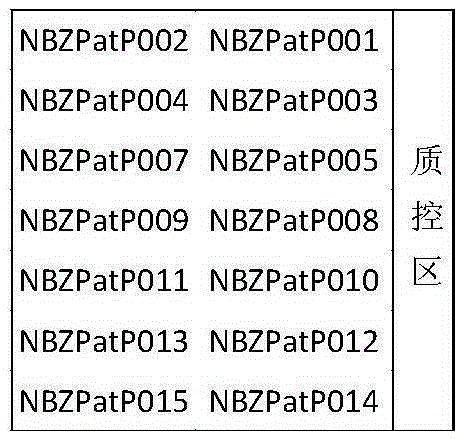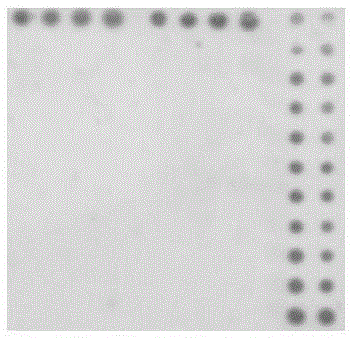Gene chip for detecting vibrio harveyi colony and using method of gene chip
A technology of Vibrio Harveylius and gene chip, which is applied in the field of gene chip detection of Vibrio Harveylius, can solve the problems of highly similar probe phenotype and genotype, rapid and accurate identification of Vibrio Harveylius, etc. The time of detection, the effect of improving identification ability and improving specificity
- Summary
- Abstract
- Description
- Claims
- Application Information
AI Technical Summary
Problems solved by technology
Method used
Image
Examples
specific Embodiment 1
[0036] Probe Preparation
[0037] 1. Target detection strains and target genes
[0038] The present invention selects Vibrio harvei group, which is an important common pathogenic bacteria in seawater cultured animals, as the detection object, including Vibrio alginolyticus, Vibrio kansaii, Vibrio harveii, Vibrio natrium, Vibrio parahaemolyticus, and rotifers Vibrio, all strains are used toxR gene is the target gene.
[0039] 2. Probe design
[0040] The present invention uses 18-30bp oligonucleotide probes. The basic requirement of probe parameters is specific and efficient hybridization, probe T m The value remains similar and fluctuates within 10°C; the number of consecutive complementary bases forming dimers and hairpin structures is less than 4 (values are less than 4.5kcal / mol); the consecutive matching bases between the probe and the non-target gene sequence The number of bases is less than 7 bases; the number of base mismatches between the probe and the target g...
specific Embodiment 2
[0044] Utilize the probe designed in the above specific embodiment one to prepare a gene chip for detecting Vibrio Harvey group, the specific steps are as follows:
[0045] 1. Preparation of probe mother solution
[0046] Prepare the probe freeze-dried powder with RNAase-free water (i.e. DEPC-treated water) to make a 100 μm / L mother solution. After shaking and mixing, centrifuge at 4°C and 5000rpm / min for 1min to obtain the probe mother solution, which is stored at -20°C;
[0047] 2. Preparation before sampling
[0048] Take a 0.2mL microcentrifuge tube, add 10μL of probe mother solution and 10μL of sampling buffer (SSC) in sequence, shake and mix well, then centrifuge at 4°C and 5000rpm / min for 1min, take the supernatant and load it into a 384-well plate ;
[0049] 3. Spotting
[0050] Confirm the matrix of the spot sheet, and control the humidity (75%) and temperature (23°C) of the spotting instrument. Using high-precision manipulator pointing technology, point the probes...
specific Embodiment 3
[0053] The method for using the gene chip prepared in the above-mentioned specific embodiment 2 for detecting Vibrio harveii group, the specific steps are as follows:
[0054] 1. Sample selection:
[0055] Model strain used: Vibrio alginolyticus (ATCC17749 T ), Vibrio campestris (MCCC1H0050 T ), Vibrio Harvey (MCCC1H0031 T ), Sodium Vibrio (MCCC1H0025 T ), Vibrio parahaemolyticus (MCCC1A02609 T ) and Vibrio rotifers (CAIM577 T ); environmental strains: Vibrio alginolyticus (NBV00022); standard strain samples of seven bacteria, the strain DNA was extracted by phenol chloroform isoamyl alcohol extraction.
[0056] 2. Primer design and synthesis
[0057] Using Primer5.0 against 6 kinds of Vibrio toxR Primers were designed for the conserved regions of the gene. According to the requirements of the primer design principles, each primer was analyzed with Oligo7 software to analyze the parameters of the primers, including the secondary structure, to exclude inappropriate pri...
PUM
 Login to View More
Login to View More Abstract
Description
Claims
Application Information
 Login to View More
Login to View More - R&D
- Intellectual Property
- Life Sciences
- Materials
- Tech Scout
- Unparalleled Data Quality
- Higher Quality Content
- 60% Fewer Hallucinations
Browse by: Latest US Patents, China's latest patents, Technical Efficacy Thesaurus, Application Domain, Technology Topic, Popular Technical Reports.
© 2025 PatSnap. All rights reserved.Legal|Privacy policy|Modern Slavery Act Transparency Statement|Sitemap|About US| Contact US: help@patsnap.com



